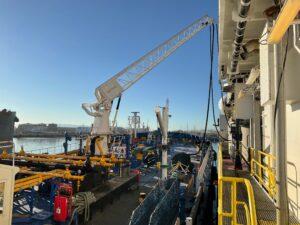
Expedition 390 fuel, distance, time, and speed, as told through data
To increase accessibility to our expedition, click to listen to the page text read aloud.
We are excited to have so many ship-to-shore broadcasts scheduled for Expedition 390. In addition to providing teachers Educator Resources for EXP 390 for our two months at sea, we are providing some data that we collected during our time on the water. We suggest some questions you can use as a starting point to engage your students with the data. There are plenty of additional ways students can build their quantitative skills from our expedition, such as generating graphs for comparison or seeing if they can make any observations on their own.
Ship fuel

JOIDES Resolution is a diesel electric ship, which means that diesel engines run generators to produce the electricity we need for all of our daily activities, from running laboratory equipment to powering the lights on board. The ship has the capacity to hold 997,152 USG (United States gallons) of diesel fuel, which is the same as 3,217 mt (metric tons) (JR ship brochure). Our Daily Operations Report (DOR) shares how much fuel we use each day and how much is remaining on board. We departed Cape Town, South Africa, on April 12 with 746,045 USG of fuel (2300.5 mt).
Ship transit data
Additional data are presented in the Daily Operations Report, including the distance JOIDES Resolution has traveled each day, the time we spent in motion versus in one location (thanks to our dynamic positioning system and the thrusters keeping us in place!), and the speed of the ship while in transit. All of these combined, along with our fuel usage, presents a fascinating look into the connections and relationships between our time on the water and our fuel usage.
We share some starter questions for teachers to use with students while exploring our ship’s fuel and transit data (*note to teachers, you can have students work with USG values instead of mt from our table if a gallon is an easier unit for students to visualize):
- Before JOIDES Resolution left Cape Town, we received two bunker barges of diesel. One transfer of fuel was 500.2 mt, and the second transfer was 500.2 mt. How much fuel, in total, was loaded on to the JR?
- Your answer to the previous question shows how much fuel was loaded on to the JR. If the JR left Cape Town with a total of 2,300.5 mt of fuel, how much fuel did the JR have on board before it received the two bunker barges of fuel?
- What is the total amount of fuel we used on this expedition? What is the total distance we traveled?
- If you were to plot the data for our distance traveled and/or ship speed, what type of graph would you create? Which data would you put on each axis? Would this be the same type of graph to plot daily fuel usage, or would you use something else? Explain.
- Which day had the highest amount of fuel used? Was it the same day that had the highest distance traveled, and/or ship speed? Why might these days be the same date or different dates?
- Why do many of our dates have a zero in the columns for distance, time, and speed? What do you think we were doing on those dates?
- What other data could you look at to better understand why some days had the JR using more fuel than others?
Here you can access the full fuel and ship’s transit data for the expedition in the spreadsheet.
*Click on this link to open the entire file in Google Sheets (viewer mode only)
For additional quantitative exercises working with data from Expedition 390, please visit our other blog posts:
- Expedition 390 wind and ship’s heading, as told through data
- Expedition 390 ship motion (heave), as told through data
- Blue Skies and Cloud Cover on Expedition 390 (*cloud cover data for the full expedition)
- Our Transit to the First Drill Site, As Told Through Data (*includes daily data for time of travel, distance, speed, wind, waves, swell, heave, during our initial nine-day transit)